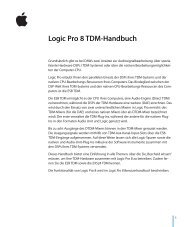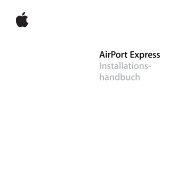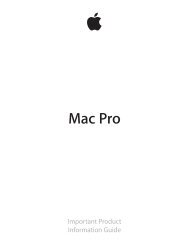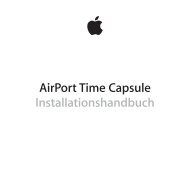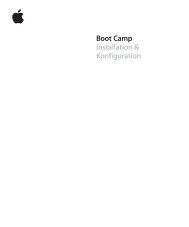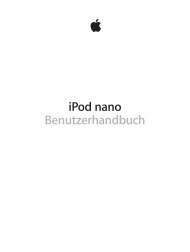iPhone User Guide - Support - Apple
iPhone User Guide - Support - Apple
iPhone User Guide - Support - Apple
You also want an ePaper? Increase the reach of your titles
YUMPU automatically turns print PDFs into web optimized ePapers that Google loves.
Set up your own Wi-Fi network. If you have an unconfigured AirPort base station turned on<br />
and within range, you can use <strong>iPhone</strong> to set it up. Go to Settings > Wi-Fi and look for “Set up an<br />
AirPort base station.” Tap your base station and the Setup Assistant will do the rest.<br />
Manage an AirPort network. If <strong>iPhone</strong> is connected to an AirPort base station, go to Settings ><br />
Wi-Fi, tap next to the network name, then tap Manage this Network. If you haven’t yet<br />
downloaded AirPort Utility, tap OK to open the App Store and download it.<br />
Connect to the Internet<br />
<strong>iPhone</strong> connects to the Internet whenever necessary, using a Wi-Fi connection (if available) or<br />
your carrier’s cellular network. For information about connecting to a Wi-Fi network, see Connect<br />
to Wi-Fi, above.<br />
When an app needs to use the Internet, <strong>iPhone</strong> does the following, in order:<br />
••<br />
Connects over the most recently used available Wi-Fi network<br />
••<br />
Shows a list of Wi-Fi networks in range, and connects using the one you choose<br />
••<br />
Connects over the cellular data network, if available<br />
Note: If a Wi-Fi connection to the Internet isn’t available, apps and services may transfer data<br />
over your carrier’s cellular network, which may result in additional fees. Contact your carrier<br />
for information about your cellular data plan rates. To manage cellular data usage, see Cellular<br />
settings on page 153.<br />
Set up mail and other accounts<br />
<strong>iPhone</strong> works with iCloud, Microsoft Exchange, and many of the most popular Internet-based<br />
mail, contacts, and calendar service providers.<br />
You can set up a free iCloud account when you first set up <strong>iPhone</strong>, or later in Settings. See<br />
iCloud on page 17.<br />
Set up an account. Go to Settings > Mail, Contacts, Calendars > Add Account. If you’re setting up<br />
an iCloud account, you can also do that in Settings > iCloud.<br />
You can add contacts using an LDAP or CardDAV account, if your company or organization<br />
supports it. See Add contacts on page 114.<br />
You can add calendars using a CalDAV calendar account, and you can subscribe to iCalendar (.ics)<br />
calendars or import them from Mail. See Use multiple calendars on page 70.<br />
<strong>Apple</strong> ID<br />
An <strong>Apple</strong> ID is the login you use for just about everything you do with <strong>Apple</strong>, including using<br />
iCloud to store your content, downloading apps from the App Store, and buying songs, movies,<br />
and TV shows from the iTunes Store.<br />
You need only one <strong>Apple</strong> ID for everything you do with <strong>Apple</strong>. If you have an <strong>Apple</strong> ID, use it<br />
when you first set up <strong>iPhone</strong>, and whenever you need to sign in to use an <strong>Apple</strong> service. If you<br />
don’t already have an <strong>Apple</strong> ID, you can create one when you’re asked to sign in.<br />
Create an <strong>Apple</strong> ID. Go to Settings > iTunes & App Stores and tap Sign In. (If you’re already<br />
signed in and want to create another <strong>Apple</strong> ID, first tap your <strong>Apple</strong> ID, then tap Sign Out.)<br />
For more information, see appleid.apple.com.<br />
Chapter 2 Getting Started 16



